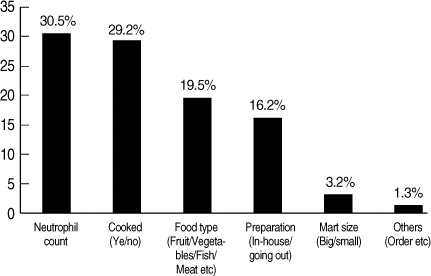J Korean Oncol Nurs.
2010 Aug;10(2):210-217.
Survey on Dietary Restrictions for Neutropenic Patients
- Affiliations
-
- 1Department of Nursing, Pusan National University Hospital, Busan, Korea.
- 2College of Nursing, Pusan National University, Busan, Korea. jeongis@pusan.ac.kr
- 3Department of Nursing, Silla University, Busan, Korea.
Abstract
- PURPOSE
This survey was aimed to examine the current dietary restrictions practices for neutropenic patients among hospitals with 500 and more beds.
METHODS
Self-administered questionnaires were sent to 100 head or charge nurses of oncology or hemato-oncology wards by mail during October 2009, and 51 questionnaires were returned. The data were analyzed with descriptive statistics using SPSS (WIN version 12.0).
RESULTS
Of the hospitals surveyed, 47.1% (n=24) had guidelines on the dietary restrictions, and 80.4% (n=41) placed patients with neutropenia on restricted diets. The major decisional criteria of the dietary restriction was absolute neutrophil count (30.5%) and cooking status (29.2%). The most commonly restricted foods were raw fish or fresh meat (98.0%), uncooked intestine (98.0%), raw eggs (98.0%), draught beer (96.1%), and fresh fruits or vegetables (86.3%).
CONCLUSION
The results showed variation in pattern of dietary restrictions and lower rate of guideline among hospitals, so that the need for the standard dietary restriction guideline is high. However, the role of diet in the development of infection in neutropenic patients is still unclear, which makes it difficult to establish dietary restriction guideline. Therefore, additional research are required to identify the relationship between dietary factors and infections.
Keyword
MeSH Terms
Figure
Reference
-
1. Kim NJ, Choe KW. Infections in neutropenic patients. J Infect Chemother. 2000. 18:369–377.2. Kim BJ, Kim YH, Jun MH, Choi JS, Gong SH, Seol ME, et al. Symptom management for cancer patients. 2000. Seoul: Hyunmoonsa.3. Barber FD. Management of fever in neutropenic patients with cancer. Nurs Clin North Am. 2001. 36:631–644.4. Moody K, Finlay J, Mancuso C, Charlson M. Feasibility and safety of a pilot randomized trial of infection rate: neutropenic diet versus standard food safety guidelines. J Pediatr Hematol Oncol. 2006. 28:126–133.
Article5. Mank AP, Davies M. Research subgroup of the European Group for Blood and Marrow Transplantation Nurses Group (EBMT-NG). Examining low bacterial dietary practice: a survey on low bacterial food. Eur J Oncol Nurs. 2008. 12:342–348.
Article6. Loudon KW, Coke AP, Burnie JP, Shaw AJ, Oppenheim BA, Morris CQ. Kitchens as a source of Aspergillus niger infection. J Hosp Infect. 1996. 32:191–198.
Article7. Wilson BJ. Dietary recommendations for neutropenic patients. Semin Oncol Nurs. 2002. 18:44–49.
Article8. Moody K, Charlson M, Finlay J. The neutropenic diet: what's the evidence? J Pediatr Hematol Oncol. 2002. 24:717–721.
Article9. van Tiel F, Harbers MM, Terporten PH, van Boxtel RT, Kessels AG, Voss GB, et al. Normal hospital and low-bacterial diet in patients with cytopenia after intensive chemotherapy for hematological malignancy: a study of safety. Ann Oncol. 2007. 18:1080–1084.
Article10. Normen L, Bosaeus I, Ekman T. Nutritional therapy during bone marrow transplantation. An overview. Scand J Food Nutr. 1996. 40:56–160.11. Centers for Disease Control and Prevention. Guidelines for preventing opportunistic infections among hematopoietic stem cell transplant recipients. MMWR Recomm Rep. 2000. 49(RR-10):1–125.12. Keep food safe. Gateway to government food safety information. accessed on 14 March 2010. Available at: URL: http://www.foodsafety.gov/keep/index.html.13. Reheis CE. Symposium on infections in the compromised host. neutropenia. causes, complications, treatment, and resulting nursing care. Nurs Clin North Am. 1985. 20:219–225.14. Smith LH, Besser SG. Dietary restrictions for patients with neutropenia: a survey of institutional practices. Oncol Nurs Forum. 2000. 27:515–520.15. Low bacterial diet. The Ohio State University Medical Center. accessed on 14 March 2010. Available at: URL: http://medicalcenter.osu.edu/PatientEd/Materials/PDFDocs/nut-diet/nut-other/lo-bac.pdf.16. French MR, Levy-Milane R, Zibrik D. A survey of the use of low microbial diets in pediatric bone marrow transplant programs. J Am Diet Assoc. 2001. 101:1194–1198.
Article17. Moe GL. Bloch A.S, editor. Low microbial diets for patients with granulocytopenia. Nutrition management of the cancer patient. 1990. Rockville,MD: Aspen Publication;125–133.18. Carter LW. Influences of nutrition and stress on people at risk for neutropenia: nursing implications. Oncol Nurs Forum. 1993. 20:1241–1250.19. Hwang EM. Analysis and evaluation of Vancomycin use [dissertation]. 2008. Seoul: Ewha Womans Univ..
- Full Text Links
- Actions
-
Cited
- CITED
-
- Close
- Share
- Similar articles
-
- Neutropenic Enterocolitis after Chemotherapy for Colon Cancer
- Fatal Neutropenic Enterocolitis during Pegylated Interferon and Ribavirin Combination Therapy for Chronic Hepatitis C Virus Infection
- The Influence of Coronavirus Disease 2019 Pandemic-Related Daily Life Restrictions on Daily Life Satisfaction
- The Short Stature in Atopic Dermatitis Patients: Are Atopic Children Really Small for Their Age?
- Traditional Chinese Pregnancy Restrictions, Health-Related Quality of Life and Perceived Stress among Pregnant Women in Macao, China


